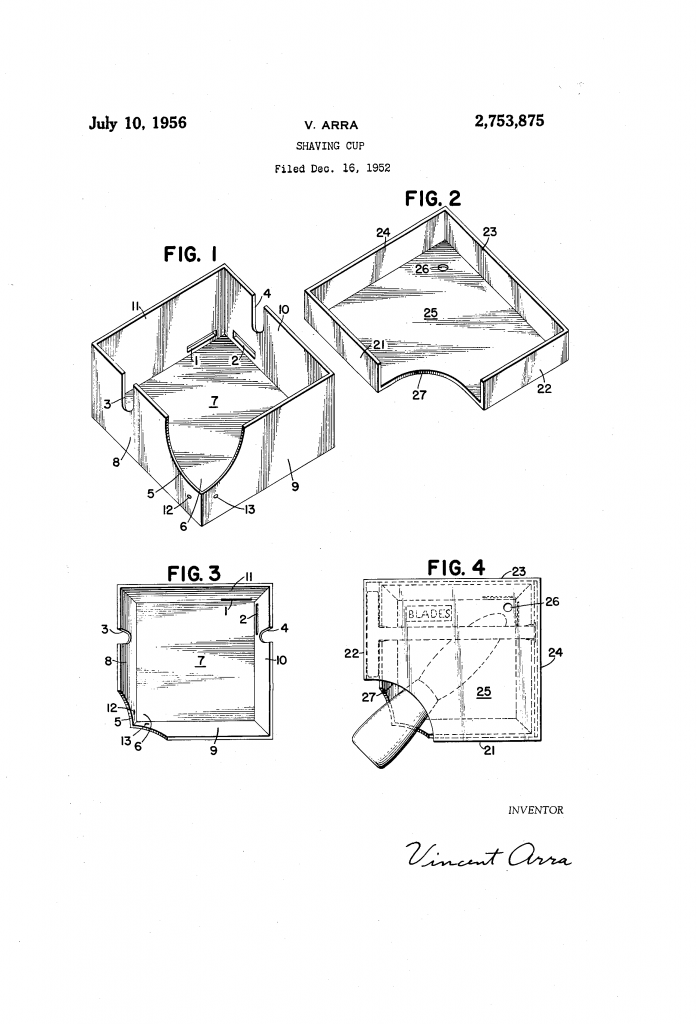Even a neat freak like to shave. And to make things tidy afterwards. Which is why the square shaving cup invented by Vincent Arra might be just the thing. Patent was filed in 1952, and granted in 1956, and have more numbers and arrows than most patents for shaving cups.
A lot more numbers and arrows. Let’s pick those apart, shall we?
Most inventers starts out to solve a problem. It may be solving an imaginary problem – such as Fowler’s corrosion free shaving lather – but the intent is there. Mr Arra was trying to solve the problem of the shaving brush staying soggy and getting bent. In the words of the patent:
The invention relates to improvements in shaving cups; whereas, the shaving cups until now have been used to keep the soap and brush in them, thus the soap remained wet and got soggy, and the bristles of the brush remained wet and became bent from the weight of the brush-handle.
From the introduction to US patent 2,753,875
Attempts to remedy this objectionable condition have been made by patents. My invention gives unique and different remedy in that, it permits the containment of the soap and brush in the cup, and in addition, it also provides for the containment of a safety razor and razorblades. Thus all the tools and items for shaving are kept together with the lathering cup. Furthermore they are kept by my invention orderly, convenient and clean.
Mr Arra sought to do all these things by shaping his shaving cup into something less… cuplike.
A square shaving cup for a neat freak
For ease of cleaning, Mr Arra suggested making his square shaving cup out of plastic. Various features and cut outs served various roles.

Figures 1 and 3 shows the cup-like object in perspective and from above. Figure 2 shows the lid upside down. And finally figure 4 shows how everything is supposed to fit together. I am going to use figure 1 as my frame of reference.
In the bottom corner there is a large cutout (5), with matching one (27) in the lid. This serves as a brush holder, so the knot of the brush is near the ventilation slits (1 and 2). There is also a ventilation hole (26) in the lid.
Under the cutout for the brush are two eyeholes (12 and 13) which allows the shaver to secure a quarter soap in that corner with a thread or toothpick.
In the lower left and upper right sidewalls there are two cutouts (3 and 4) that will hold a razor. The lid is rectangular, so it also covers the razor handle and head.
In the storage position, the brush is placed over the soap. It’s taken as an article of faith that the handle will clear the soap. The razor is places in the cutout, and there is space to place a tuck of blades in the corner next to the handle. And then the lid is put on, making everything neat and tidy.
Thoughts on the neat freak shaving cup
As seen from almost seventy years in the future, there are quite a few issues with Mr Arra’s shaving cup.
For starters, the two ventilation slits looks to be small and placed low. This – along with the tiny hole in the lid – means that the knot wouldn’t get enough airflow to dry easily. The two slits also means that water and lather would easily spill out the side. This not only makes a mess, but also makes the square cup harder to hold.
With the lack of airflow, the interior of the shaving cup will be damp. This not only means that your knot might bend, but the soap stays wet too. Two of the things Mr Arra tried to avoid. The dampness may also affect your razor if it’s not rustproof. The damp would certainly have an effect on the tuck of blades – stainless blades were not the norm in the early fifties.
So in the end, and in my opinion, the invention fails to fix the problem it set out to do. One could, perhaps, flip the lid over and place the cup on the lid when not in use. That would fix the airflow and dampness issues, but would also be less orderly, convenient and clean…
The whole patent can be read at Google Patents. If you’ve enjoyed this and want to read more shavings patents and the like, I got a lot of them on my blog.
